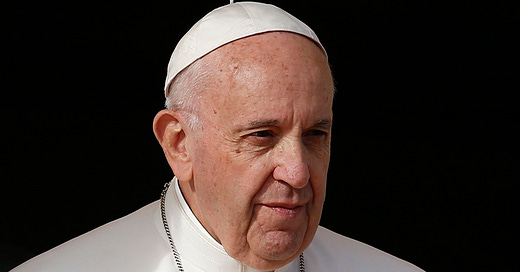Manufactured Narratives
The "occasion" for Traditiones and the possible uncovering of a Public Relations stunt. Facts are stubborn things.
The postmodern insight that the world is, in some very salient ways, constructed by narratives is helpful in trying to make sense out of the world. Though often couched strictly in terms of power, it is equally important to recognize that narratives serve not only power, but also authority. Authority rests within the legitimacy of a narrative, and so power-consolidation apes this by manufacturing narratives that look like authoritative but are really naked attempts to secure power.
Traditiones Custodes and a Preoccupied and Saddened Pontiff
got her hands on at least some of the documentation of the report that “occasioned” the abrogation of Pope Benedict’s Summorum Pontificum (SP) by Pope Francis and the issuing of his moto proprio Traditiones Custodes (TC). Contrary to the claims by Team Francis that the bishops surveyed were deeply concerned by the Traditional Latin Mass (TLM) and the contestation of this organized and hostile band of ideological malcontents against Vatican II, it appears that many of the bishops held no such reservations about SP.So, the proposed reasons were not really reasons at all. The TLM was viciously suppressed, and micromanaged to the point of regulating even the publication of mass times in local bulletins.
Ironies abound, especially in consideration of the very real wish on the part of the Vatican II fathers to decentralize authority from Rome back to the local ordinaries. They feared that the managerial authority had been too tightly handled by Rome, turning the local ordinaries into “branch managers” of a sort. In light of this, Pope Francis’ move flies right in the face of the Council. Yet, it was allegedly done to preserve the desires of the Council.
The usual suspects were out in full force telling everyone that Diane’s reporting was ideologically motivated and therefore inaccurate, and she was motivated to frame it thusly because she is a “trad”. Note that the documentation she secured was pretty clear. Note, too, that this calls into question the stated reasons.
Did the pope lie?
Perhaps there is sufficient verbal cover (and creative legal terminology) to affirm the negative. Did he tell the truth, the whole truth, and nothing but the truth? I think not. Perhaps more details will be forthcoming, and not just an “executive report” that was leaked. But we have not (yet) been privy to the cache of documents. There has been no transparency, and so a narrative has been created in that peculiar patois known as “spin.” The problem with all spin is that it often relies on half-truths and obfuscations. If only everyone was patient and waited for the full release. Why wasn’t it released? What was the holdup? Who “owns” the study?
Well Pope Francis could have released the whole thing. At any point in this whole regrettable affair. At any point, this entire melodrama could have been eliminated by transparency. But apparently, transparency is a threat to order. We can’t claim that Pope Francis was unaware of the report—especially in the curious, particular detail of him seizing the document and looking at it himself.
So why didn’t they release the whole report? It depends upon what the job was for in the first place. It is my speculation that the desire to suppress the TLM was pre-ordained.
has a great write up of the reporting, as well as some speculation as to what really happened. Read it HERE, as I think it passes my initial sniff test. It should disturb us all that there is a very real chance that the former Holy Father resorted to at worst a flat out lie, at best a bungled Public Relations opp. So I want to talk about the deeper pattern of Public Relations, and the Fog Machine of War. I will use C. S. Lewis’s masterful mid-century novel That Hideous Strength to illustrate the dark side of Public Relations. I will circle back to tie these two stories together. Now on to the novel.What Does it Profit a Man…
Mark Studdock, a young progressive ambitious academic has been courted and recruited by the National Institute for Coordinated Experiments, or the N.I.C.E. In the novel it functions like a Silicon Valley startup, an essentially private enterprise with support deep in the machine of the state. Think of today’s Private Public Partnership, or PPP. He is a sociologist by training. For what, precisely, he is being recruited for they never really say. But with hints and gestures, it appears that he is getting in on the ground floor of something huge, and of course, lucrative. He is played like a cheap fiddle, and it appears that the vagaries of his position are part of the plan of ensnarement. After much gamesmanship, Mark goes all in. They invite him into the Inner Ring. In a “private” conversation with the head of security Miss Hardcastle (or “Fairy”), he is let in on what they want him for: Public Relations.
Keep reading with a 7-day free trial
Subscribe to The Underneath to keep reading this post and get 7 days of free access to the full post archives.





